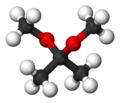| |||
| Names | |||
|---|---|---|---|
| Preferred IUPAC name 2,2-Dimethoxypropane | |||
| Other names acetone dimethyl acetal | |||
| Identifiers | |||
3D model (JSmol) | |||
| ChEMBL | |||
| ChemSpider | |||
| ECHA InfoCard | 100.000.961 | ||
| EC Number |
| ||
PubChem CID | |||
| UNII | |||
CompTox Dashboard (EPA) | |||
| |||
| |||
| Properties | |||
| C5H12O2 | |||
| Molar mass | 104.15 g/mol | ||
| Appearance | Colorless liquid | ||
| Density | 0.85 g/cm3 | ||
| Melting point | −47 °C (−53 °F; 226 K) | ||
| Boiling point | 83 °C (181 °F; 356 K) | ||
| 15 g/L (20 °C) | |||
| Hazards | |||
| GHS labelling: | |||
  | |||
| Danger | |||
| H225, H315, H319, H335 | |||
| P210, P233, P240, P241, P242, P243, P261, P264, P271, P280, P302+P352, P303+P361+P353, P304+P340, P305+P351+P338, P312, P321, P332+P313, P337+P313, P362, P370+P378, P403+P233, P403+P235, P405, P501 | |||
| Safety data sheet (SDS) | External MSDS | ||
Except where otherwise noted, data are given for materials in their standard state (at 25 °C [77 °F], 100 kPa). | |||
2,2-Dimethoxypropane (DMP) is an organic compound with the formula (CH3)2C(OCH3)2. A colorless liquid, it is the product of the condensation of acetone and methanol. DMP is used as a water scavenger in water-sensitive reactions. Upon acid-catalyzed reaction, DMP reacts quantitatively with water to form acetone and methanol. This property can be used to accurately determine the amount of water in a sample, alternatively to the Karl Fischer method. [2] [3]
DMP is used to prepare acetonides from diols, where it is both a synthon for acetone and a scavenger for the water byproduct: [4] [5]
- RCHOHCHOHCH2 + (CH3O)2C(CH3)2 → RCHCHCH2O2C(CH3)2 + 2 CH3OH
It can also be used to prepare methyl esters from carboxylic acids, where it acts as a water scavenger and source of methanol: [6]
- RCOOH + CH3OH → RCOOCH3 + H2O
- H2O + (CH3)2C(OCH3)2 —> 2CH3OH + (CH3)2C(O)
Dimethoxypropane is an intermediate for the synthesis of 2-methoxypropene.
In histology, DMP is used for the dehydration of animal tissue. [7]

